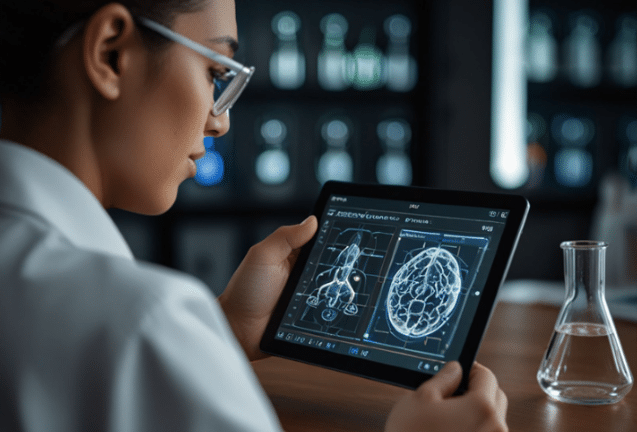Stroke is a leading cause of disability and death worldwide, affecting millions of people each year. Rapid diagnosis and timely intervention are crucial for improving outcomes, as every second counts when it comes to saving brain tissue. Traditionally, stroke management has been reliant on clinical expertise and imaging technologies such as CT and MRI scans. However, with the advent of artificial intelligence (AI), stroke care is undergoing a paradigm shift, offering faster, more precise and highly efficient diagnosis and treatment planning.
AI in Stroke Diagnosis: Enhancing Speed and Accuracy
One of the most critical aspects of stroke management is early and accurate detection. AI-powered tools are transforming stroke diagnosis by analyzing brain scans in real-time, significantly reducing the time required for interpretation. AI algorithms, trained on vast datasets of imaging studies, can swiftly differentiate between ischemic and hemorrhagic strokes—two distinct types that require vastly different treatment approaches.
AI-driven imaging platforms assist radiologists and neurologists by automatically identifying occluded arteries, detecting hemorrhages, and even assessing the extent of brain damage. This allows healthcare professionals to make quicker, more informed decisions, expediting the administration of life-saving treatments such as thrombolysis or mechanical thrombectomy.
AI in Treatment Planning and Decision Support
Beyond diagnosis, AI is playing a vital role in personalized treatment strategies. AI models can predict patient outcomes based on historical data, helping doctors determine the best course of action. Machine learning algorithms assess factors like age, medical history, stroke severity, and comorbidities to recommend tailored treatment plans.
For ischemic strokes, where blood clots obstruct blood flow to the brain, AI can rapidly identify suitable candidates for thrombolytic therapy (clot-busting drugs) or mechanical thrombectomy (clot removal). Similarly, in hemorrhagic strokes, AI can predict bleeding patterns and recommend optimal surgical interventions. Such precision minimizes the risk of complications and improves overall patient prognosis.
Remote Stroke Care and AI-Driven Telemedicine
In rural and underserved regions where access to stroke specialists is limited, AI-driven telemedicine is bridging the gap. AI-enabled mobile applications and cloud-based platforms facilitate real-time consultations between emergency physicians and stroke experts, ensuring that patients receive timely interventions even in remote settings.
For instance, AI-based stroke triage systems help paramedics assess stroke symptoms on-site, transmitting critical data to hospitals before the patient arrives. This allows stroke teams to prepare for immediate intervention, drastically reducing door-to-needle time—a key factor in stroke survival and recovery.
AI in Rehabilitation and Recovery Monitoring
Stroke rehabilitation is a long and complex process, requiring continuous monitoring and personalized therapy. AI-driven rehabilitation tools are transforming post-stroke care by enabling real-time tracking of a patient’s recovery progress. Wearable devices equipped with AI analyze movement patterns, detect muscle activity, and provide personalized feedback to optimize rehabilitation exercises.
AI-powered virtual assistants and chatbots offer cognitive and speech therapy to stroke survivors, helping them regain lost functions. Additionally, AI-driven predictive analytics help doctors anticipate potential complications such as recurrent strokes or post-stroke depression, allowing for proactive intervention.
The Future of AI in Stroke Care
As AI technology continues to evolve, its applications in stroke management will become even more sophisticated. Researchers are developing AI models that integrate genetic and biomarker data to predict stroke risk with greater accuracy. Furthermore, AI-driven robotic-assisted surgery is emerging as a promising tool for complex neurovascular procedures, enhancing precision and minimizing invasiveness.
However, the integration of AI in stroke care also presents challenges, including data privacy concerns, the need for robust validation of AI models, and ensuring equitable access to AI-driven technologies across all healthcare settings. Addressing these challenges will be crucial in realizing the full potential of AI in stroke management.
Artificial intelligence is revolutionizing stroke management by improving diagnosis, accelerating treatment, enabling remote care, and enhancing rehabilitation. With its ability to process vast amounts of data and provide real-time insights, AI is not only saving lives but also improving the quality of life for stroke survivors. As the healthcare industry continues to embrace AI-driven innovations, the dream of reducing stroke-related mortality and disability is becoming a reality.
By integrating AI into every stage of stroke care, from emergency response to long-term recovery, we are moving towards a future where stroke outcomes are no longer dictated by time and geography but by the power of intelligent technology.
(Author is Group Director and Head of the Department of Neurointervention at Paras Hospital, Gurugram)









